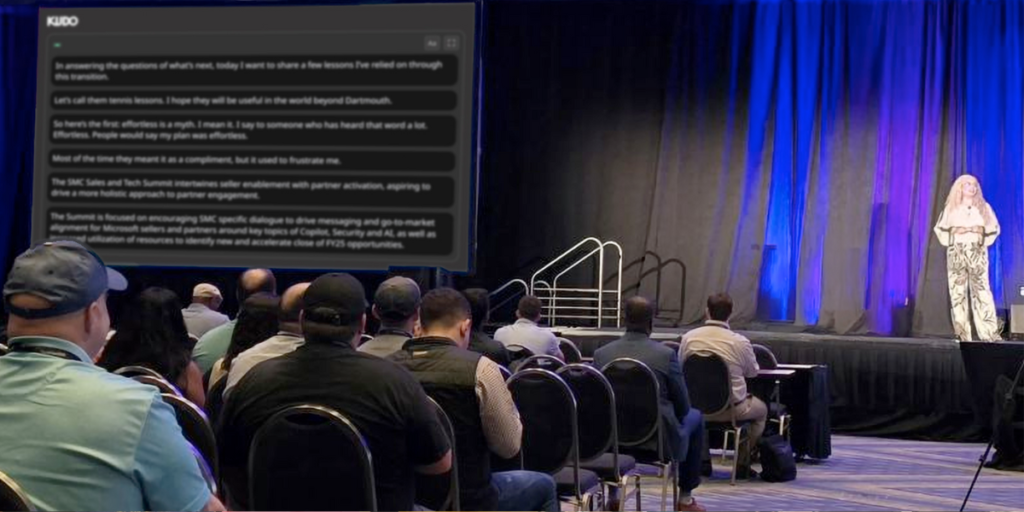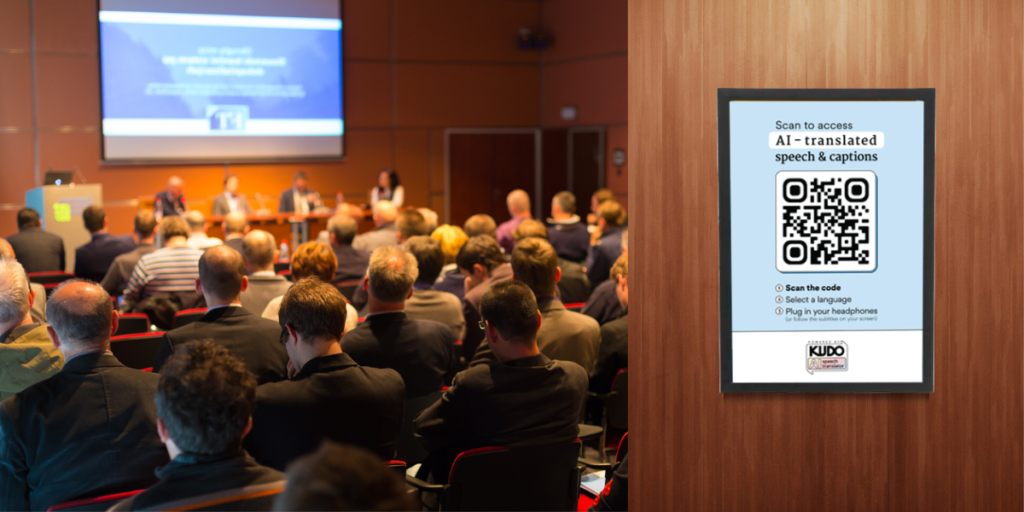As a whole, the AI language translator market is projected to reach $42.75 billion by 2030, including applications in multilingual text, voice, and video translations.
Looking at the data for worldwide adoption of multilingual tools in 2024, it’s safe to say we can rule out overoptimism within these predictions; numbers speak louder than words, and what we saw last year underlines an increasing demand for real-time language accessibility solutions across a range of industries and use cases.
So, read on for your ultimate guide to everything important that happened in the AI speech translation market in 2024, including our insider analysis on what’s most been fueling its boom.

2024: A Breakout Year for AI Speech Translation
If 2022 and 2023 were the years in which ‘AI’ entered the global vernacular, 2024 was the year it went from being a trendy tool to experiment with to a mainstream solution used by millions in their everyday personal and professional life.
Here are the 10 most important data points about AI speech translation in 2024:
Market Size and Growth
1. The AI in language translation market as a whole grew from $1.88 billion in 2023 to $2.34 billion in 2024, representing a compound annual growth rate (CAGR) of 24.9% (The Business Research Company).
2. In 2024, the speech-to-speech translation market size alone was estimated at $0.56 billion, indicating a rapidly growing segment within the AI translation industry (Mordor Intelligence).
Key Users & Industry Adoption
3. Education: AI speech translation in higher education saw significant adoption, with a growing number of institutions using AI for real-time translation during lectures and discussions to support multilingual student populations. Estimates suggest that over 40% of universities in 2024 looked to integrate AI speech translation tools in their classrooms (EDUCAUSE Review).
4. Corporate Use: 75% of companies surveyed in 2024 plan to use Large Language Models (LLM) in their organization by next year, indicating a significant shift towards AI-driven translation solutions (Smartling).
5. Government and Public Services: According to multiple regional surveys, 35% of city councils in the U.S. began piloting AI translation tools to meet legal accessibility requirements for non-English speakers in 2024.
6. Language Services: 2024 saw a significant rise in AI adoption within the language service industry, with the proportion of language service companies using large language models (LLM) increasing sevenfold (Multilingual).
7. Translation Professionals: Over 70% of independent language professionals in Europe reported using machine translation to some extent, highlighting its integration into professional workflows (Redokun).
8. Marketing Localization: Approximately 39% of marketers incorporated machine translation into their localization strategies, with 83% expressing confidence in the quality of the translations (Redokun).
Increased AI Language Coverage
9. Google Translate: In June 2024, Google expanded its language offerings by adding 110 new languages, bringing the total to over 330 languages (Google). This included 31 African languages such as Tamazight, Afar, Wolof, Dyula, and Baoulé, representing 200 million speakers (Google).
10. Meta’s NLLB-200 Model: Meta AI developed the NLLB-200 model in 2024, capable of translating across 200 different languages with state-of-the-art quality (Smartling).
What Drove AI Speech Translation Growth in 2024?
So, we’ve looked at the ‘what’, but what about the ‘why’? Based on KUDO’s own data from our AI speech translator as well as wider industry signs, we believe there are two main factors that accelerated the adoption of AI translation in 2024:
-
Tighter Accessibility Laws & Requirements
From ‘nice’ to ‘need-to-have’; in 2024, legislative developments worldwide emphasized the importance of providing language accessibility, prompting organizations to invest in AI translation tools and assistive listening technologies (which can be solved through real-time closed captioning as provided by some AI speech translators). Notable among these are:
- Americans with Disabilities Act (ADA) Compliance: The ADA requires businesses to provide appropriate communication aids and services, such as captions, interpreters, notetakers, and assistive listening devices, to ensure effective communication with individuals who have disabilities. The Department of Justice has clarified that these requirements extend to online goods, services, privileges, or activities, urging businesses to enhance their digital accessibility (ADA).
- European Accessibility Act (EAA): The EAA, which came into effect in 2024, mandates that products and services, including digital platforms, be accessible to people with disabilities. This legislation has driven European organizations to adopt AI-driven translation and assistive technologies to comply with the new standards
- Accessible Canada Act (ACA): The ACA focuses on identifying, removing, and preventing barriers in federal jurisdiction areas. Accessibility Standards Canada has developed standards related to information and communication technologies, encouraging organizations to implement AI translation tools and assistive listening devices to meet these standards (Accessible Canada).
Looking at the industries where we’ve seen the biggest leap in adoption of AI speech translation in 2024, there’s a clear link between the introduction of compliance requirements and the search for an all-in-one solution; the biggest newcomers to the table were from higher education, healthcare, houses of worship, legal, and public services like city councils and school districts.
At KUDO, we saw a 500% increase in client adoption for our AI speech translator from houses of worship and government entities alone in 2024. So, it’s clear that new mandates are underscoring the necessity for organizations to invest in on-demand AI translation and assistive listening technologies to foster more inclusive citizen engagement meetings, lessons, legal consultations, and worship services for everyone.
But what about non-public facing organizations, where we also saw a 311% increase in product usage at KUDO throughout 2024? The increase in AI speech translation being used for internal announcements, employee training, board meetings, live events, and more in the private sector might be chalked down to the following:

-
Technological Advancements in AI
No, we don’t just mean flashy new features that make headlines in TechCrunch one day and disappear the next, we mean long-term product enhancements that address the two most vital aspects of any AI speech translator: translation quality and user experience.
2024 was a game-changing year for both, removing much of the initial 2023 apprehension from private corporations and small to medium sized enterprises around whether AI speech translation is ‘good enough’ yet for everyday use (see our A-Z guide on AI speech translation quality for more information).
Let’s take a quick look at some of the key technology milestones from 2024:
- Increased AI Accuracy: 2024 saw significant breakthroughs in real-time translation accuracy. Innovations in neural architectures, context-based translations, and voice modulation served to expand the use cases for AI speech tools far beyond their more basic capabilities in 2023 as providers reworked their speech-to-speech processes to incorporate the latest and best new machine translation technologies. At KUDO, for example, we saw a 24% increase in translation quality from English to Spanish, French, German, and Latin/Greek rooted languages, and a 16% improvements for Asian languages like Chinese, Japanese, Korean, and Vietnamese after launching KUDO AI v.3.0—our revamped AI engine—in 2024.
- Decreased AI Latency: As essential to quality is the lag between a person speaking and the AI speech translator rendering the translation, and in this domain, we saw even greater advances in 2024. Azure’s AI Speech Service introduced real-time translation capable of delivering translations in less than five seconds, for example (Tech Community). SimulTron, similarly, achieved superior BLEU (Bilingual Evaluation Understudy) scores and reduced latency compared to previous real-time S2ST methods, facilitating more immediate translations (arXiv). KUDO’s own AI speech translator shaved a second off its overall latency in 2024, with our new conversational translation mode averaging a three-second latency.
- Advancements in Speech-to-Text APIs: In the same vein, the development of advanced speech-to-text APIs in 2024 improved real-time transcription accuracy, better supporting the integration of AI speech translation in videoconferencing platforms. These innovations enhanced the quality of live translation during online meetings and events (Krisp), which remain the most popular use case for AI speech translation.
- More Flexible Ways to Access AI: Perhaps one of the biggest product improvements we saw in 2024 was the investment in making AI speech translation more widely available in-person and on any device. Offline machine translation has been around for years when it comes to textual or consecutive interpretation (translating sentence-by-sentence like a record-and-playback feature), but now the focus of the industry is on real-time, continuous translation of speech on-the-go. At KUDO, much of our R&D focus in 2024 was spent on improving the mobile version of KUDO AI. This scan-to-access, web-based solution makes live speech translation accessible anywhere without users needing to download our app or create an account, and was treated to several new display and audio enhancements in 2024 for better accessibility.
In short, AI speech translation became better at translating accurately, more reliable, and able to be used in many more ways and locations in 2024.
What Else Happened in Machine Translation in 2024?
While KUDO AI was built for real-time, continuous AI speech translation back and forth, it’s always interesting to follow trends from the wider machine translation market. And again, 2024 saw continued innovation in multiple areas, notably:
On-Device Translation Capabilities
- Enhanced Speech Translation in Wearable Devices: Companies like Samsung integrated advanced AI functionalities into their devices, offering features such as real-time translations and transcriptions. Meta also introduced live translation features in its Ray-Ban smart glasses, enabling real-time speech translation between languages such as English, Spanish, French, and Italian (The Verge).
Voice Isochrony & Preservation Technologies
- Solutions like TransVIP maintained original speaker voice characteristics and isochrony in 2024, a breakthrough for natural speech translation in video dubbing and presentations (arXiv).
Low-Resource Language Expansion
- Companies like Nvidia and Google extended their language support to underserved languages such as Hindi, Wolof, Dyula, and others in Africa and Asia (Reuters). This is a significant advantage of AI when it comes to providing coverage for low-resource languages where human translators and interpreters are hard to find. This trend was echoed in the speech translation world, too; to keep up with client demand and ensure wider accessibility, KUDO AI was enhanced with around 20 new low-resource languages in 2024, for example, including Swahili, Pashto, Kannada, and Gujarati.

Where Does Human Interpretation Figure?
Did 2024 spell doom and gloom for the human interpretation industry? Absolutely not. Usage of KUDO’s interpreter Marketplace actually grew by 30% in 2024, with more language interpreters being booked for meetings and events than last year. As predicted after the launch of our AI speech translator in January 2023, what we are seeing is AI supplementing human interpretation offerings, not replacing them, and this is reflected in the fact that a third of KUDO’s clients today utilize both human interpretation and KUDO AI for different use cases within their organization.
Where translation quality, fluency, and naturalness is concerned, AI still has a long way to go. A 2024 article highlighted that while DeepL has made significant strides in translation quality, for example, it still encounters challenges, particularly with idiomatic expressions and context-specific translations. Users noted improvements in 2024 but also report instances where translations may not fully capture the intended meaning (El País).
Similarly, research from 2024 indicates that Google Translate’s accuracy varies across language pairs. For instance, translations from English to Spanish have been reported to achieve up to 94% accuracy, while less common language pairs may experience lower accuracy rates (Lokalise).
So, despite all the technology and product enhancements we saw for AI speech translation in 2024, human interpretation isn’t going anywhere (see our article entitled ‘2024 in Review: Human Interpretation Market Data & Trends’ for an in-depth analysis).
Key Takeaways & What’s Next for AI?
To conclude, 2024 marked a transformative year for AI speech translation, cementing its place as a mainstream tool for global communication. With a market size growth of nearly 25% and substantial advancements in accuracy, latency, and device accessibility, solutions like KUDO AI expanded their reach across education, corporate sectors, government services, and more.
Legislative changes like the European Accessibility Act and the Accessible Canada Act further spurred adoption, making real-time language translation indispensable for inclusivity. While AI bridged gaps in underserved and low-resource languages, human interpretation maintained its value, reinforcing a collaborative future where technology supplements rather than replaces human expertise.
Read our article on ‘2025 Trends and Predictions for AI Speech Translation’ to find out what our experts are expecting to see in the industry this year.